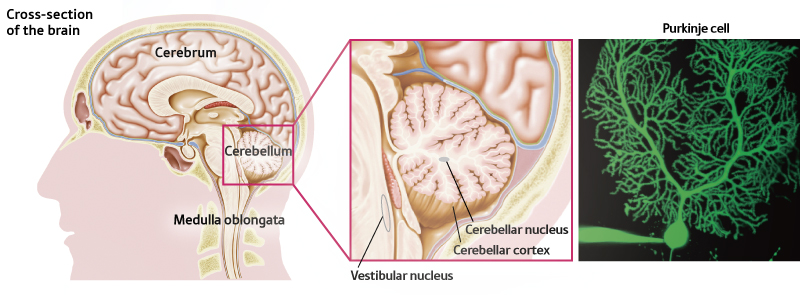Cerebellar cortex circuitry
The cerebellum is an area of the brain which functions largely outside of the area of conscious alertness. Its best-known functions are included in coordinating motor activities and learning new motor skills. It is mainly included in adjusting activities to meet new circumstances. Though, in addition to these well-known functions, there is a growing alertness that cerebellar systems might be included in other types of learning and also in emotional reactivity.
The cerebellum, situated dorsal to brain stem, is partly hidden by the big occipital lobes of the cortex. The cerebellar cortex is intensely grooved and emerges as thin, transverse leaves known as folia. There is a deeper transverse fold on the greater aspect of the cerebellum known as the primary fissure. These fissures define the posterior end of the anterior lobe. The posterolateral fissure splits the small flocculonodular lobe from the remainder of the cerebellum. The section of the cerebellum in the midline is not as prominent as the lateral hemispheres and is known as the vermis. It is significant to note that the cerebellum is connected to ipsilateral body functions. Hence, whenever the cerebellum connects to sections of the brain which have crossed functions (like the cerebral cortex), the connection should cross.

Before proceeding with a conversation of the connections of the various areas of the cerebellum it is suitable to explain the cerebellar cortex. The cellular structure of the cerebellar cortex is totally montonous, with every area of the cortex, in spite of of its functions or connections, appearing the same. Therefore, the differences in function from one region to another are based completely on difference in inputs and output from the cortex. It is exciting to note that there are more neurons in the cerebellar cortex than the rest of the brain combined. Moreover, there are only five different kinds of neurons in the cortex. These emerge in three layers, the granule cell layer is deepest, the Purkinje cell layer is in the center and a superficial layer is known as the molecular layer. Not amazingly, granule cells (the most several cell kind in the human brain) are in the granule cell layer along with Golgi cells. The Purkinje cells emerge in a single layer, the Purkinje cell layer. Lastly, the molecular layer consists of basket and stellate cells. All of these cell kinds, with the exception of the granule cells, use the inhibitory neurotransmitter, i.e. GABA. It is also significant to note that the Purkinje cell is the only neuronal kind that has an axon which leaves the cerebellar cortex. The remaining cell kinds make connections only in this thin layer of the cerebellar cortex.